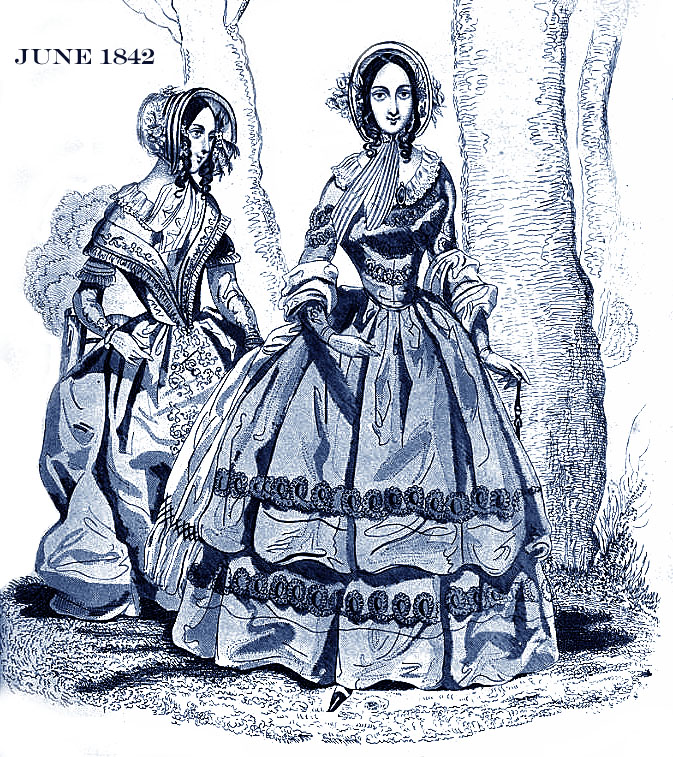LATEST PARIS FASHIONS {from the The New York Visitor and Lady’s Album}
Selected from the French and English Monthlies, brought by the Steamer Acadia.
Hats.–The only alteration in hats is that the crown inclines a little more forward, and the brims spread out more on the temples, to show as much of the hair as possible.
Drawn Capotes are very fashionable, composed of shot Gros de Naples* of the many and varied colours for the Spring, ornamented with rows of notched ribbon, arranged over each drawing. The strings are composed of the same material, edged with the ribbon. Hats and capotes are now composed of citron and white, pink and white, lilac and pink, and striped crape; of these, both the stripes and the grounds are very delicate. Many very elegant dress hats are composed of China crape, trimmed with ribbons of gauze tulle, the satin edges of which are shaded.
The leading portion of hats introduced this month, do not descend so low on the cheeks as those of some months past; they either have bavolets* or are turned up behind ; the crowns also incline more forward. The most surprising alteration in the ornaments of hats which has taken place for some time is that of transposing the drooping flower or bouquet to an upright position.
Caps.–The pretty little Venetian caps will now be adopted for the evening. They are composed of gymped blond, and embellished with a garland of primroses, which are now quite the rage ; they are formed short at the ears, with a pompon of ribbon, though some have a simple flower placed on each side of the temples, finishing with a bow of ribbon, which floats over the back of the neck.
Head Dresses.–Among the numerous and fashionable coiffures of the day, the following are the most splendid. The Medicis toque, composed of brilliants, attaching bouquets of the most beautiful feathers. And the capuce of Jeanne Grey, composed of velvet with rows of pearl, in the form of a demi-circle, showing the face, and descending on both sides just below the hair.
Walking Dresses.–As I hinted to you in one of my last, dresses continue to be made in the most simple style, yet with great regard to pure elegance. There appears to be a decided preference to the corsage Amazone, no doubt in consequence of the splendid embroidery which is seen most to advantage on this corsage.– The sleeves are tight, and the pelerine or cape, which is of full size, is embroidered, edged with gympe and lace fringe ; the colour corresponds with that of the material of the dress. Another very pretty style of walking or morning dress, is composed of taffetas glace*, with a trimming of four or five flounces of lace, or three or four rows of broad fringe.
Evening Dresses.–Blue Pekin d’ Orient is a favourite material for evening toilette; to these dresses the skirt is made open on both sides, allowing an under white satin figured skirt to be seen ; the outer skirt is bordered with an English lace, put on plain, which runs round the back of the dress; the body and sleeves are also surrounded with the same sort of lace. Bows of ribbon are placed at distances, attaching the opening at the side, the dress is then edged all round with a silver twist. Many dresses are composed of velour epingle* worn over a satin skirt opening on each side; crape and other dresses of numerous materials partake of the same style and order.
Pelisses.–The most fashionable style of pelisses is that composed of poult de soie*, embroidered down each side of the front; at the bottom of the sleeves and round the pelerine this pelisse is open at the sides, falling back to show a skirt of the same colour underneath, the effect of which is extremely graceful. The pelisse styles of dress are now much in vogue, and the pelisses of various kinds are fast replacing shawls, &c.
Ball Dresses.–The newest, and by far the most elegant ball dresses out of a great many, is composed of crepe, in the form of a tunique, and open at the sides, attached with a row of variegated carnations, placed zig-zag upon the sides of the skirt. This style of dress is free from confused ornaments, yet elegantly chaste.
Lace Pelerines.–Are made open in front and with three falls, and fastened round the neck with a bow or tuft of ribbon.
*Explanation of Terms
Gros de Naples–Plain woven silk fabric of Italian origin, made with ply warp or organzine and a heavier two-ply filling, forming a grain more pronounced than found in taffeta; used for coats, hats, etc.
Bavolet ( ba vo lay ) – A cap worn by French peasant women. A 19c style called the CURTAIN BONNET, had a back ruffle, called a bavolet, that shaded the neck.
Taffetas Glace–French for highly finished changeable taffeta.
Velours Epingle–Lightweight, solid colored French silk velvet with uncut pile.
Poult de Soie–Solid colored silk fabric, made in plain weave with a two-ply warp and a heavier filling containing more than two strands and forming cross ribs; used for dresses.

